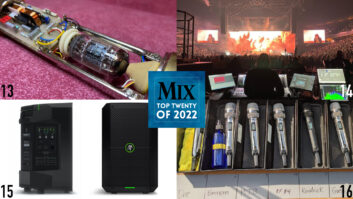In business vernacular, my business is not the desirable model: too many different products are serviced, the chief cook and bottle washer are easily distracted and there are no employees. I don’t think my company has the exclusive rights to these claims, but on the upside, diversity keeps the workflow consistent while providing ample material for this column. The downside is the laundry list of things not done. (I know I’m not alone there.) At least the new year is right around the corner. This month, I want to follow up on the past year’s research and open some neglected packages.
ANALYZE THIS WITH THAT

Since reviewing NTI’s Minilyzer (www.nt-instruments.com), its countenance has appeared in so many “Tech’s Files” columns that George Petersen started making comments about the crude screen captures. Well, goodbye to awkward pix and hello MiniLINK, NTI’s hardware interface and visualization software that links Minilyzer (and Digilyzer) to a PC. Surely, images like Fig. 1 will make “Tech’s Files” easier on the eyes.
Minilyzer is an affordably priced assortment of essential audio tools in a compact package. Aside from the obvious level-measurement capability, I find its spectrum analyzer a lifesaver when trying to differentiate between noise and distortion. The Minilyzer could easily claim to be the audio Swiss Army Knife of the test equipment world.
Installing MiniLINK required removing the battery cover, inserting a plug-in board (with USB interface), snapping on a new back cover (for the USB connector and cable) and installing the software/drivers and registration, all of this taking less than 10 minutes. The software automatically upgraded the firmware (at least two revisions’ worth so that the unit is now also an SPL meter with an optional calibrated mic). Pretty impressive and dang easy.
Like countless other digital products, Minilyzer has many more features than its simple face implies. And, like any piece of test equipment, Minilyzer’s performance is sensitive to interconnection; in this case, the USB connection may introduce ground current noise from the computer. Fortunately, the ‘lyzer family can store measurements for later download via MiniLINK, making it easier to explore the full potential of both the Minilyzer and the Digilyzer.
CURVE BALL
Far from being exclusive to surround sound, my series on bass management included an emphasis on the proximity effect of directional microphones. I urge anyone interested in learning more about their fave mics to collect versions of the frequency response charts that include proximity curves. Electro-Voice (www.electrovoice.com) picked up on this thread and created three mics’ worth of detailed images that can greatly minimize the guesswork during critical moments when EQ decisions must be made. Figure 2 details E-V’s N/D868 mic intended for kick drum.
FRAYED KNOT
From the high-maintenance department comes a power supply tip. When a Sony 3000 Series console power supply appeared at my doorstep, I could hardly get it into my house, let alone lift it up onto the workbench. This supply delivers four voltages: 24 volts, ±18 volts and 48 volts. (The first three outputs are protected by 20-amp ceramic fuses.)
The internal harnesses comprise unlabeled black wires terminated with crimp connectors at the bridge rectifiers and filter caps. Crimping without soldering is a no-no in high-current applications, as the heat generated at each junction gradually weakens the crimp and oxidizes the wiring to the point that it creates more heat and accelerates the insulation aging process (see Fig. 3). Fortunately, in this case, there was enough extra transformer wire to prune back four inches of funk and still reach the rectifier.

Other issues included a fried 48-volt phantom supply. This was most likely due to insufficient insulation in two places: Behind the regulator board was a thin sheet that was easily punctured by PCB component leads; and on the other side of the sheet, there were three massive heat sinks mounted to the chassis via insulators. Further investigation revealed that the pass transistors were mounted sans thermal insulators, making each sink electrically “hot.” In addition, the PCB was mounted at each end with metal brackets, which did not include enough slop tolerance to prevent accidental shorting to nearby components and PCB traces.
UPGRADE THAT 1272
All the way from Down Under comes an upgrade for the Neve 1272 module that turns the 1272 into a full-fledged mic preamp (www.jlmaudio.com). The kit includes a circuit board outfitted with a rotary gain switch, the necessary transistors and relay to provide the full range of gain offered by the 1066 and 1073 modules (see Fig. 4). Making these old modules functional is not too difficult, but unless acquired for a song, completely restoring them to like-new condition is prohibitive. The most obvious sources of funk — the pots and the switches — are both costly and labor-intensive to replace.
Using contact cleaner may be effective in the short term, but it can never completely turn back the clock for 30-something electronics. The 1272 has only one pot, and that is removed for this upgrade. I’d rather have one reliable mic pre without EQ than a funky one with.
BUDGET ACOUSTICS
Improving my control room’s acoustics has been a slow process, but the acquisition of MiniTraps (www.realtraps.com) has simplified the project. Four inches of Type-705 Fiberglas is precut and fitted into a 2×4-foot metal frame with easy-to-attach mounting holes. The Fiberglas alone can be purchased without the frame, and then wrapped in an acoustically transparent, decorative material for easy drop-in installation for a standard ceiling grid. I recommend MiniTraps for people who do not like handling Fiberglas.
Although MiniTraps are intended for corners to control boundary-related, low-frequency buildup, I suspended them parallel to the ceiling, down a few inches and about two inches from each other. Placing them directly over the engineer’s position improves imaging by absorbing early reflections caused by a low ceiling.
Popping balloons on one side of the room while listening on the other revealed resonance coming from Sheetrock™-covered ductwork. Thinner, homemade traps were applied over these areas as dam-pers, although a real solution would be to rip them out and start over. (Treating the windows while preserving the incoming light is another challenge.) Wavelab’s decay analysis feature documents the before and after. Look for results in the new year.
Eddie Ciletti is hoping to finish his control room, produce an instructional video, build a few mic preamps and compressors and lose 20 pounds in the year 2004. Check out Eddie’s site atwww.tangible-technology.com.







